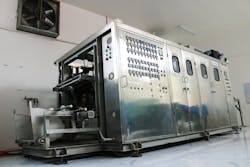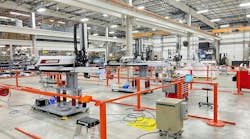Thermoformers are not on the cutting edge of using automation or investing in smart factory techniques. Not yet, anyway.
That’s why it was surprising that more than half of the technical program at the SPE Thermoforming Division’s annual conference in September was devoted to smart manufacturing technologies.
Program organizers were right on target.
You could sense that many attendees recognized the value of automation, smart manufacturing and remote monitoring, but were not sure how to get started.
“COVID forced us into some changes,” said Brian Golden, senior account executive for aftermarket at SencorpWhite in Hyannis, Mass., who moderated some of the smart factory sessions.
Related: SPE Thermoforming Division announces parts contest winners
Golden said thermoformers were forced to make radical changes to many of their processes, starting with machine and tool acceptance, remote installations and virtual monitoring. “We quickly researched and vetted a variety of new technologies, newly applied to thermoforming,” he said. “From FaceTime and WhatsApp to Microsoft HoloLens and augmented reality, we had to get at the nexus of the human-machine interface and remote-monitoring tools.”
The severe shortage of factory workers, exacerbated by COVID-19, has pushed manufacturing executives to look at more automation to keep their plants running.
“Even though the rise of Industry 4.0 has been discussed for some time now, in the world of thermoforming, the pace of adoption accelerated rapidly in the past year as many plastics manufacturers experienced both a spike in demand and a bottleneck in supply,” Golden said.
Thermoformers are not alone in being forced to pivot to new, smarter ways of operating their plants. In the future, we may look back at this point in history as the most profound period of change in the past century.
I suggest this might turn out to be a good thing for manufacturing.
China, among others, has made heavy investments in manufacturing. Many of their plastics processing plants are highly automated and equipped with late-model processing machinery.
While thermoforming might never achieve lights-out operation, there are some basic elements of smart factories that provide benefits. Here are five to consider:
- Autonomous mobile robots (AMRs) can move raw materials, products and packages around a plant. This technology is mature and is a first step in plant automation. AMRs can take on a significant number of tasks that have been performed manually.
- Robotic arms can replace human arms in a great many tasks. While not frequently seen in thermoforming plants, they are routinely deployed in injection molding operations. There was a time when lengthy programming requirements made robots impractical in thermoforming, but drag-and-drop programming today is quick and no longer requires complex code writing.
- Thermoformers can develop fully automatic production cells capable of going from flat sheets to trimmed parts without operator intervention. This requires integration of multiple processes but delivers high-quality parts at lower cost.
- Vision and surface-measuring tools can perform inspection and quality-control functions.
- Manufacturers can benefit from machine data. We are at a stage where many processors are collecting data from machine sensors, but not yet effectively using it to improve cycle times, predict maintenance downtime and speed up changeovers.
None of these elements applies solely to thermoformers, but the conference showed a thirst for information. Good for them. Tackling smart factory technology can be a daunting task for small and medium-sized companies, but it is one thermoformers can no longer afford to put off.
See our smart factory coverage for more information.
Who is going to pay?
This is a question facing the plastics industry.
Congress is considering a proposal to charge virgin resin makers 20 cents per pound for material used in some single-use products. The new tax is part of the $3.5 trillion spending bill moving through Congress.
Perc Pineda, chief economist at the Plastics Industry Association (PLASTICS), argues the tax will hurt resin manufacturing and eventually increase processors’ costs as it is passed along. The theory is that processors will then pass it on to brand owners, causing them to reduce the amount of virgin plastic in their single-use products.
Pineda provides a thoughtful, data-based argument against the tax in this month’s PLASTICS column.
Ron Shinn, editor






